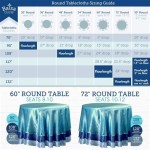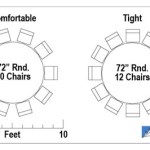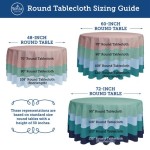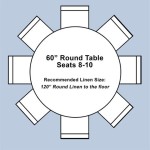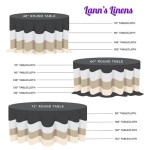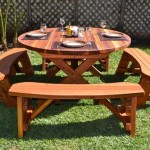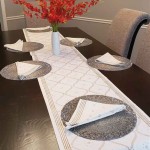Round vs. Rectangle Dining Table: Which One is Right for You?
Selecting a dining table is a crucial decision in furnishing a home. The dining table often serves as a central gathering place for meals, conversations, and celebrations. The shape of the table, specifically round versus rectangle, significantly impacts the functionality, aesthetics, and overall ambiance of the dining space. Understanding the nuances of each shape is essential to making an informed choice that suits individual needs and preferences.
Both round and rectangle dining tables offer distinct advantages and disadvantages. The ideal choice depends on factors such as the size and shape of the room, the number of people typically seated, the desired style, and the intended use of the table beyond dining. This article explores the key considerations when choosing between round and rectangle dining tables to aid in making the most suitable selection.
Space Considerations: Optimizing the Room's Layout
One of the primary factors influencing the choice between round and rectangle dining tables is the available space and the room's geometry. Rectangle tables are generally better suited for longer, narrower rooms, as they can effectively utilize the linear space. Round tables, conversely, tend to work well in square or smaller rooms, promoting a sense of intimacy and preventing the room from feeling cramped.
A rectangle table maximizes seating along its length, making it ideal for hosting larger gatherings. However, in a smaller room, a large rectangle table can dominate the space, hindering movement and creating a visually heavy impression. In such cases, a round table might be a more practical option. A round table allows for easier navigation around the table, particularly in tighter spaces.
The footprint of each table shape also plays a crucial role. While a rectangle table might consume more floor space overall, its linear form can be positioned against a wall or in a corner to conserve space when not in use. A round table, however, requires clearance on all sides, making it less adaptable to being placed directly against a wall. Consider the ease of movement around the table and the overall flow of the room when deciding on the shape.
Consider the dimensions of the room carefully and measure the available space before making a decision. Account for the table's size, chair placement, and the need for adequate walking space around the table. Mocking up the table's footprint with tape on the floor can provide a visual representation of how the table will fit into the room.
Seating Capacity and Functionality: Accommodating Guests
The number of people regularly using the dining table is a vital consideration. Rectangle tables generally offer greater seating capacity compared to round tables of similar surface area. The linear design facilitates adding more chairs along the sides, making them suitable for families or individuals who frequently entertain guests.
Round tables encourage conversation and visual connection among diners. The circular shape allows everyone to see and interact with each other, fostering a sense of intimacy and inclusivity. This makes round tables a popular choice for smaller groups or intimate gatherings.
However, the seating capacity of a round table is limited by its diameter. Adding too many chairs around a round table can result in overcrowding and discomfort. Furthermore, reaching items in the center of a large round table can be challenging for diners seated further away. Lazy Susans or rotating trays can help alleviate this issue, but they also consume valuable table space.
Rectangle tables provide greater flexibility in seating arrangements. Chairs can be added or removed as needed, and extra leaves can often be inserted to extend the table's length for larger gatherings. This adaptability makes rectangle tables a practical choice for those who require varying seating capacities. Consider the average number of diners and the frequency of hosting larger gatherings when evaluating seating capacity. If seating is a constraint, a rectangle table is often a better way to maximize the amount of people who can be seated comfortably.
Style and Aesthetics: Complementing Interior Design
The shape of the dining table contributes significantly to the overall style and aesthetic of the dining room. Rectangle tables tend to convey a sense of formality and tradition, making them well-suited for traditional or formal dining rooms. Their linear design complements rectangular or square rooms, creating a sense of balance and symmetry.
Round tables, on the other hand, often evoke a more casual and contemporary feel. Their curved shape adds a touch of softness and visual interest to a room, making them a popular choice for modern or eclectic interiors. Round tables can also help to soften the hard lines of a rectangular room, creating a more inviting and harmonious atmosphere.
The material and finish of the table also influence its style. A dark wood rectangle table with ornate details might be appropriate for a formal dining room, whereas a glass-topped round table with metal legs might be a better fit for a contemporary space. Consider the existing furniture and décor in the dining room when selecting the table's style and finish.
The placement of the table within the room also affects its visual impact. A rectangle table placed lengthwise in a narrow room can emphasize the room's linearity, while a round table placed in the center of a square room can create a focal point. Consider the overall composition of the room and how the table's shape will interact with the other elements in the space. Ultimately, the choice between round and rectangle depends on the desired aesthetic and the overall design vision for the dining room.
Functionality Beyond Dining: Multipurpose Usage
Dining tables often serve multiple purposes beyond simply providing a surface for eating. They can be used for working, studying, crafting, or playing games. The shape of the table can impact its suitability for these various activities. Rectangle tables generally offer a larger, more adaptable surface area for spreading out materials or accommodating multiple users simultaneously. This makes them well-suited for tasks that require ample workspace.
Round tables, while promoting interaction and conversation, may be less practical for tasks that require extensive surface area. The circular shape can limit the amount of space available for spreading out papers or materials, and the lack of corners can make it difficult to anchor larger items. However, round tables can be ideal for games or activities that involve shared access to a central point.
Consider how frequently the dining table will be used for purposes other than dining. If the table will primarily serve as a workspace or crafting area, a rectangle table with ample surface area may be the better choice. If the table will primarily be used for dining and social gatherings, a round table with its emphasis on interaction might be more suitable.
The height of the table and the type of chairs chosen can also affect its functionality for different activities. A taller table with comfortable chairs can be suitable for both dining and working, while a lower table with less supportive chairs may be more appropriate for casual dining and conversation. Consider the overall ergonomics of the table and chairs to ensure that they are comfortable and functional for the intended uses.
Maintenance and Cleaning: Practical Considerations
Cleaning and maintaining a dining table is an important consideration in ensuring its longevity and aesthetic appeal. The shape of the table can affect the ease of cleaning and maintaining its surface. Rectangle tables, with their straight edges and corners, can be easier to wipe down and clean than round tables with curved edges.
Spills and crumbs can accumulate in the corners of a rectangle table, requiring more attention during cleaning. Round tables, with their lack of corners, are less prone to this issue. However, the curved edges of a round table can be more challenging to clean effectively, particularly if the table has intricate detailing.
The material of the table's surface also affects its maintenance requirements. Wood tables require regular polishing and protection from scratches and water damage, while glass tables require frequent cleaning to remove fingerprints and smudges. Consider the material's durability and ease of maintenance when making a decision.
The finish of the table can also impact its resistance to stains and scratches. A durable, scratch-resistant finish can help to protect the table's surface and minimize the need for frequent repairs or refinishing. Consider the overall durability and ease of maintenance when selecting a dining table shape.

Round Vs Rectangular Dining Tables Which Is Better For You Cuura Space

Round Vs Rectangular Dining Tables How To Choose The Best For Your Space

Round Vs Rectangular Dining Table Maid2match

The Best Dining Table Shapes Castlery United States
Round Vs Rectangular Dining Tables Which Is Better For You Cuura Space

Blog House Of Oak

Are You Choosing A Dining Table Round Or Rectangular

Round Vs Rectangular Dining Tables How To Choose The Best For Your Space

Table Size Advisor Which Is Right For Me

Round Table In Rectangular Room Blogs Forums
Related Posts

